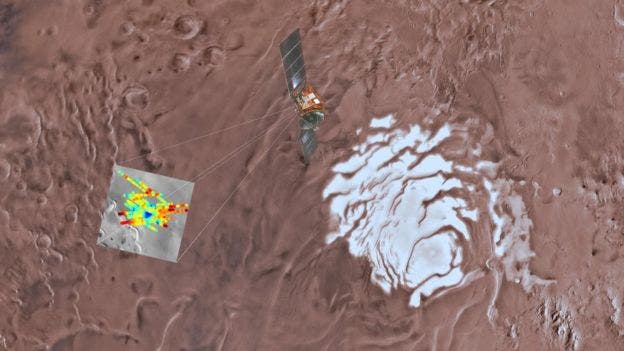
Today, there’s little doubt that Mars once had liquid water on its surface at some point in its history. For example, the Curiosity rover has provided evidence pointing to this conclusion by mineralogical studies of sediment samples collected and carried out at Gale Crater. But although contemporary Mars appears inhospitable and dry as a bone, scientists have recently announced that liquid water may be nestled in some pockets beneath the surface of the Red Planet. The latest findings reported by researchers at the Italian Space Agency suggest that a 20 kilometer-wide subglacial lake lies just 1.6 kilometers beneath the surface, near the south pole of Mars.
“This is just one small study area; it is an exciting prospect to think there could be more of these underground pockets of water elsewhere, yet to be discovered,” said lead-author Roberto Orosei in a statement.
The monumental discovery of subterranean liquid water was performed with ground-penetrating radar (GPR) on the Mars Express spacecraft, a European Space Agency (ESA) probe that has been orbiting Mars since 2003. GPR works by sending electromagnetic waves towards the ground and timing how long it takes for them to return. The travel time is dependant on the material through which it passes, so this way we can figure out what kind of materials lurk beneath a surface without viewing it directly. The technology was initially developed so the military could locate mines, but today, GPR is used in all sorts of applications, such as finding avalanche victims, micro-fissures in constructions, small archaeological objects — and, now, water on Mars!
To peer inside the Martian subsurface, Mars Express is equipped with the Mars Advanced Radar for Subsurface and Ionosphere Sounding (MARSIS) instrument, which is comprised of two 20-meter radar booms. Between May 2012 and December 2015, MARSIS surveyed the Planum Australe region, which corresponds to the southern ice cap of Mars. Its radio pulses traveled through the Martian surface and polar ice caps, then reflected back to the spacecraft’s antenna. According to the Italian Space Agency, 29 sets of radar samples were recorded, which allowed researchers to create a subterranean map almost a mile below the surface of the studied region. The map stretches about 20 kilometers across and the features identified by the scientists look eerily similar to signals generated by lakes found beneath Greenland and Antarctica on Earth.
“We interpret this feature as a stable body of liquid water on Mars,” the authors wrote in the study.

Although the first study suggesting liquid water might be found at the base of Martian polar caps was published nearly 31 years ago, the new findings mark the first tangible evidence of the presence of liquid water on the Red Planet.
On Earth, lakes under the Antarctic ice sheet can stay liquid even though the mean temperature at the surface is around -24 degrees Celsius. The thick ice thermally insulates such lakes, although, to be fair, the temperatures of subglacial lakes can hover below the freezing point of water. This kind of lake stays liquid because the water mixes with salts like magnesium, calcium, and sodium to form a brine which lowers the water’s freezing point. The saltier the water, the colder it has to be to turn into ice. Scientists think that the lake they’ve identified under the Martian ice cap is also briny.
“The long duration of Mars Express, and the exhausting effort made by the radar team to overcome many analytical challenges, enabled this much-awaited result, demonstrating that the mission and its payload still have a great science potential,” Dmitri Titov, Mars Express project scientist, said in a statement. “This thrilling discovery is a highlight for planetary science and will contribute to our understanding of the evolution of Mars, the history of water on our neighbor planet and its habitability.”
So, what’s next? The measurements need to be repeated, hopefully by other instruments, such as the Shallow Radar (SHARAD) on NASA’s Mars Reconnaissance Orbiter (MRO), in order to rule out all other explanations.
But what about life on Mars? It’s the most obvious question on everyone’s mind right now. Sheltered under more than a mile of ice, the newly identified glacial lake receives far less of the harmful radiation that strikes the Martian surface. Pressure and temperature are also at more favorable levels. Then, of course, there’s water, which by our Earthly standards is essential to life. However, no one is getting carried away right now. For instance, for the water to stay liquid, it might have to be extremely briny, which life finds challenging to cope with.
Needless to say, the findings reported by the MARSIS team are incredibly exciting, despite my cautious reporting. We’re living in very interesting times!


